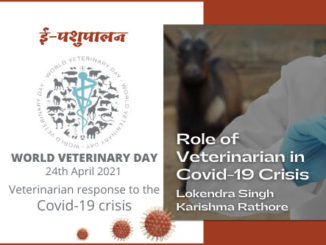As per World Health Organization, health can be defined as the state of complete physical, mental and social well-being and not merely the absence of diseases and infirmity. For humans to attain a healthy state, the contribution of the species that coexist with us in the ecosystem such as animals and plants can’t be overlooked. Therefore “Health” as a concept should not remain confined to health of human beings rather it should be expanded as an all-inclusive approach incorporating the inextricable interdependence of human, animal and environmental health.
Increased incidence of emerging zoonotic pathogens such as avian influenza, Zika virus, Ebola virus etc. have threatened global health. These are urgent issues because worldwide 60% of existing human infections are zoonotic in nature. Additionally at least 75% of the emerging infections of humans have animal origin. Besides emerging zoonoses, antimicrobial resistance (AMR), food safety and environmental health are also some of the burning issues in the world. Thus to combat these emerging public health threats, the cooperation among human, animal and environmental sciences becomes imperative to be included under the One Health umbrella. Also the recent COVID-19 pandemic has yet again emphasized on the pivotal role that One Health can play in achieving improved public health outcomes.

India is presently in a state of transition- economically, demographically, and epidemiologically- in terms of health. Over the past few decades, India has made enormous strides in the health sector, but inspite of this progress, emerging zoonotic infections such as Avian Influenza, Kyasanur Forest Disease (KFD), Nipah virus continue to pose a threat to both national and international security. Additionally issues like vector borne diseases such as Japanese Encephalitis, Zika virus, Crimean Congo Haemorrhagic Fever (CCHF) will continue to challenge public health. Besides these, AMR is one of the biggest health challenges that the world is facing and which requires immediate attention. Food-borne diseases also contribute to the global health burden. As per a study, the food borne disease burden in India was estimated to be about 100 million cases per year in 2011 which is expected to reach 150-177 million in 2030. In addition, non-communicable diseases (NCDs) such as heart disease, cancer, diabetes, and chronic pulmonary diseases have now become the leading cause of deaths in the country contributing to 60% of deaths. These health problems being frequently complex, multifactorial and transboundary requires to be approached from a comprehensive and collaborative medical, veterinary and ecological view in order to develop sustainable mitigation strategies and this need can be successfully fulfilled by the One-Health approach.
1. Emerging zoonoses
Approximately 75% of the emerging infectious diseases have zoonotic origin which means that they can be naturally transmitted from vertebrate animals to humans. The recurring outbreaks of emerging zoonotic diseases such as avian influenza (H5N1, H7N9), Nipah virus, Severe Acute Respiratory Syndrome (SARS) emphasize on the need to reconsider the interconnections between human, animals and the environment for development of effective disease prevention and control measures. One Health approach can help tackle the spread of these diseases by identifying the role of wildlife in their emergence, successfully identifying and controlling the diseases at animal level, by development of a forecast/ forewarning system that can facilitate timely reporting and interventions and by understanding the connections between biodiversity, environment and emergence of infectious diseases. Besides this, establishment of a close network of medical and veterinary laboratories can help in the real time collection of data for monitoring the activity of the pathogens and the disease both in animals and human. One Health approach can help facilitate the formation of Rapid Response Teams comprising of individuals from multiple disciplines that can help forward information to the authorities responsible in shortest possible time for initiating interventions.
2. Food safety
To achieve food safety, One Health advocates the cross-sectoral collaboration between the animal health, plant health, the food control, and the human health sector. It considers the full farm-to-fork chain starting with animal feed, plants and ending in human consumption of crops & animal food products. With the One Health approach different aspects of food safety such as spread of zoonotic diseases via food animals, spread of AMR along the food chain by eating animal based foods, problem of pesticide and antibiotic residues in food, human diseases caused by plant pathogens can be linked together to understand the complex web of transmission and to identify the interventions. This approach recommends the veterinarian in case of animals, medical doctors in case of humans, agricultural workers in case of plants, public health veterinarians in case of products of animal origin, food and consumer authorities such as FSSAI in relation to pesticide / antibiotic residues in crops, to step in in order to obliterate the cycle of transmission.
3. Antimicrobial Resistance (AMR)
India is a hot spot concerning antibiotic use and the present usage for animal production is estimated to be 30 kg/km2, which is expected to grow 312% by 2030. It has also been observed that global consumption of antibiotics in animals exceeds the total antibiotic usage in human medical care. The practices like over-prescription of antimicrobials, not completing prescribed course of antimicrobial treatment along with its extensive use of antibiotics as growth promoters in animals escalate the number of bacteria developing resistance, which can be transmitted to humans directly or indirectly. Thus, the measures to contain AMR cannot be limited to only humans. Under One Health approach, strategies can be developed by representatives from the respective fields working together to ensure an integrative approach to reduce the use of antimicrobial and its abuse in human, food animals, wildlife, aquaculture and environmental sectors and the spread of resistant organisms and resistance genes within and between these sectors and around the globe.
4. Vector-borne Diseases (VBDs)
The global burden of VBDs is estimated to be 17% of the burden of all infectious diseases. The incidence of VBDs are widely influenced by the human activities such as population growth, escalated human movement, climate change etc. Thus, the One Health approach can be used to understand how factors like high population growth rate, deforestation, human settlements in pristine forests etc. can result in ecological disequilibrium that causes loss of biodiversity and heightened host-vector contact rate. Besides, a disrupted ecosystem also favors the rapid spillover of vector borne pathogen and change in the rate of temperature, precipitation and humidity can affect the ecology of vectors, ultimately increasing the risk of spread to human and animal population.
5. Non- communicable Diseases (NCDs)
One Health can also aid in understanding of NCDs. Comparative medicine which is being used from a long time ago, relates the similarities and differences among the human and veterinary medicine and offers benefits to humans through development of animal models. NCDs like diabetes, cancer and obesity can be well understood with the application of comparative medicine. Diabetes is very common in cats and the feline diabetes closely resembles type 2 diabetes in people in several ways such as in both the species, the disease is associated with obesity and is typically seen in middle-age patients. As per the Feline Models of Type 2 Diabetes Mellitus, increased obesity and reduced physical activity are the reasons contributing to increased incidence of diabetes in both cats and humans. Cats can become a good animal model as they share many risk factors, features and complications with humans and hence studies in cats may lead to better ways to prevent and treat diabetes in both felines and humans.
Conclusions
- The convergence of people, animals, and our environment has created a new dynamic in which the health of each domain is inextricably interconnected. This remarkable convergence is a critical factor in disease emergence.
- For effective control of emerging diseases, instead of just focusing on the risk to human health, the strategies should also be applied to animals and the environment.
- The most critical barrier to the acceptance of One Health lies in our own bias and artificial separation between veterinary, environment health and public health.
- The One Health approach can serve the purpose of understanding and mitigating complex health problems that have defied a more trans-disciplinary and sectoral approach.
It will be appropriate to end this article by quoting the lines of Paracelsus (an alchemist and physician) “Once a disease has entered the body, all parts which are healthy must fight it: not one alone, but all. Because a disease might mean their common death. Nature knows this; and Nature attacks the disease with whatever help she can muster” In these lines Paracelsus has built up an analogy between ‘body’ and the “community” and ‘all parts’ may be taken to mean ‘sectors that constitute the community’.







Be the first to comment